The AMD Radeon R9 290X Review
by Ryan Smith on October 24, 2013 12:01 AM EST- Posted in
- GPUs
- AMD
- Radeon
- Hawaii
- Radeon 200
GRID 2
The final game in our benchmark suite is also our racing entry, Codemasters’ GRID 2. Codemasters continues to set the bar for graphical fidelity in racing games, and with GRID 2 they’ve gone back to racing on the pavement, bringing to life cities and highways alike. Based on their in-house EGO engine, GRID 2 includes a DirectCompute based advanced lighting system in its highest quality settings, which incurs a significant performance penalty but does a good job of emulating more realistic lighting within the game world.
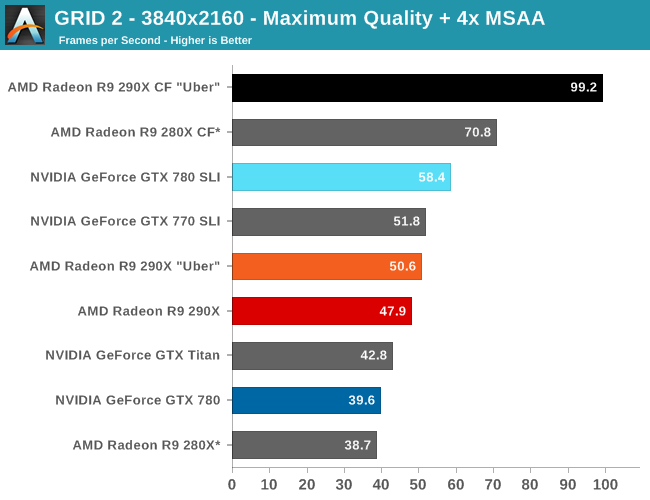
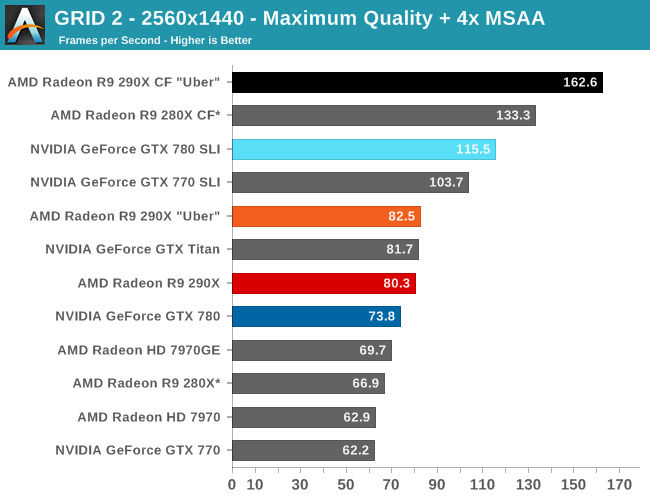
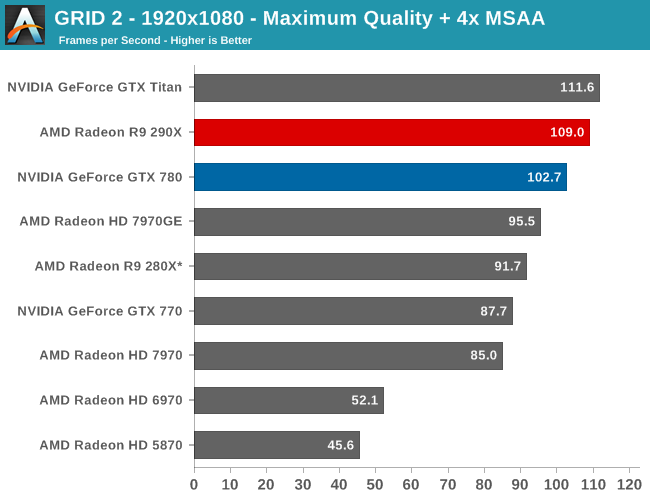
For as good looking as GRID 2 is, it continues to surprise us just how easy it is to run with everything cranked up, even the DirectCompute lighting system and MSAA (Forward Rendering for the win!). At 2560 the 290X has the performance advantage by 9%, but we are getting somewhat academic since it’s 80fps versus 74fps, placing both well above 60fps. Though 120Hz gamers may still find the gap of interest.
Moving up to 4K, we can still keep everything turned up including the MSAA, while pulling off respectable single-GPU framerates and great multi-GPU framerates. To no surprise at this point, the 290X further extends its lead at 4K to 21%, but as usually is the case you really want two GPUs here to get the best framerates. In which case the 290X CF is the runaway winner, achieving a scaling factor of 96% at 4K versus NVIDIA’s 47%, and 97% versus 57% at 2560. This means the GTX 780 SLI is going to fall just short of 60fps once more at 4K, leaving the 290X CF alone at 99fps.
Unfortunately for AMD their drivers coupled with GRID 2 currently blows a gasket when trying to use 4K @ 60Hz, as GRID 2 immediately crashes when trying to load with 4K/Eyefinity enabled. We can still test at 30Hz, but those stellar 4K framerates aren’t going to be usable for gaming until AMD and Codemasters get that bug sorted out.
Finally, it’s interesting to note that for the 290X this is the game where it gains the least on the 280X. The 290X performance advantage here is just 20%, 5% lower than any other game and 10% lower than the average. The framerates at 2560 are high enough that this isn’t quite as important as in other games, but it does show that the 290X isn’t always going to maintain that 30% lead over its predecessor.
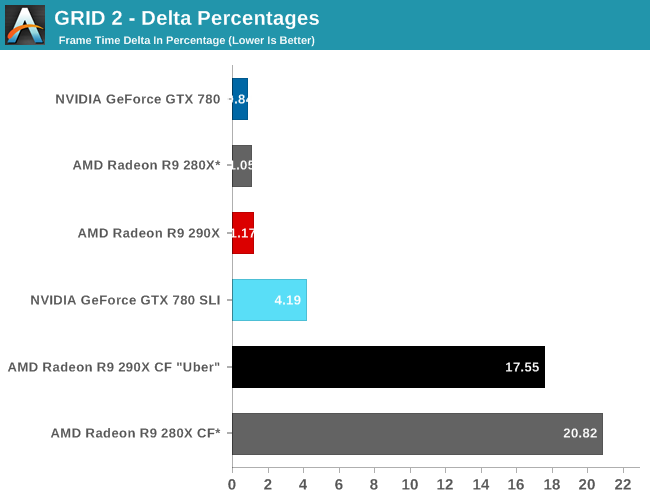
Without any capturable 4K FCAT frametimes, we’re left with the delta percentages at 2560, which more so than any other game are simply not in AMD’s favor. The GTX 780 SLI is extremely consistent here, to the point of being almost absurdly so for a multi-GPU setup. 4% is the kind of variance we expect to find with a single-GPU setup, not something incorporating multiple GPUs. AMD on the other hand, though improving over the 280X by a few percent, is merely adequate at 17%. The low frame times will further reduce the real world impact of the difference between the GTX 780 SLI and 290X CF here, but this is another game AMD could stand some improvements, even if it costs AMD some of the 290X’s very strong CF scaling factor.


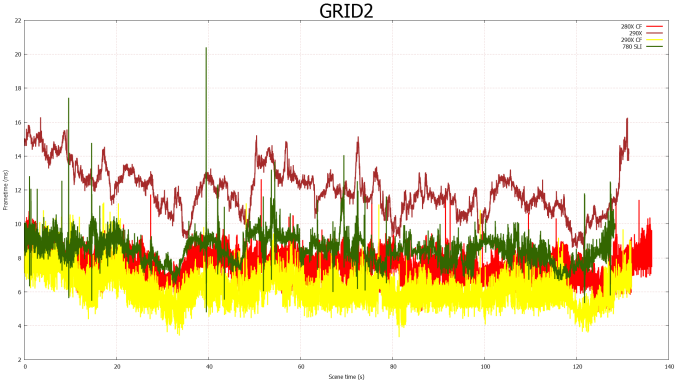








396 Comments
View All Comments
zeock9 - Thursday, October 24, 2013 - link
I'm sure they can/What I'm interested in the most is how they go about doing that in relation to their now oddly placed top dog, Titan, and at what price point.
ninjaquick - Thursday, October 24, 2013 - link
So, the 780Ti is going to magically be 25% faster than the Titan? I'd like to see where they managed to get that much number crunching out of an ancient process node.Kevin G - Friday, October 25, 2013 - link
The problem for nVidia is that they have wait for a new process node to go much beyond Titan's performance. GK110 is 550 mm^2 which is on the edge of what TSMC can reliably manufacture. Without 20 nm, nVidia can't add more functional units to really increase performance. (They could enable one more SMX cluster but that'd only be good for <10% increase at equal clocks.)TSMC 20 nm production is set to come online in early 2014 which would mean end products would start shipping at Q2 at the earliest. nVidia has wisely moved their large die releases to the end of the generation so we're likely to see the GM104 chips before the GM100.
DMCalloway - Friday, October 25, 2013 - link
The 780ti is going to be GK110 based, and should be out mid November so not sure where you're getting taped out? They'll push the clocks, enable another SMX cluster, and price it at or less than current gtx 780 prices. This of course is a good thing because it brings green team's pricing/performance inline with where it should've been at launch.JDG1980 - Thursday, October 24, 2013 - link
My prediction: The 780 Ti will have the same graphics specs as the original Titan, but will still have crippled GPGPU performance to maintain market segmentation. The new Titan will be the full GK110 chip with no parts disabled.AFQ - Thursday, October 24, 2013 - link
Since when does AnandTech started posting half-assed reviews?Ananke - Thursday, October 24, 2013 - link
Honestly, anything with price above PS4 is dead in the market. This is really impressive card, however they will likely sell couple thousand units and that's it. The fight is going to be in the $180-200 range, and I haven't seen anything substantial there yet. NVidia is great with GTX760 - sells a lot and the margins are great.p.p. I will most likely get R9-280X
piroroadkill - Thursday, October 24, 2013 - link
Uh, not sure what you're talking about.The R9 270X is basically a 7870 on steroids (faster clocks, faster RAM), and is widely available for $200.
The only NVIDIA card at that price is the 660. The 660 is crap in comparison to the 270X...
The cheapest 760 is $250. Outside of the range you yourself defined.
TheJian - Friday, October 25, 2013 - link
NV sold 100,000 Titans at $1000 in a few days with many more runs in the last 8months. AMD will likely sell at least a few hundred thousand. At the current price I'd expect a few 100K at least. This is $450 less than Titan and is pretty close (excluding heat, noise, watts). It will sell pretty well and I think they should have priced it $100 higher. NV wouldn't have needed to lower 780 and AMD would have made some real money for a change. Their pricing model seems to indicate they don't like making any money EVER.http://investing.money.msn.com/investments/financi...
10yr summary...6.5Billion lost in 10yrs. Think they need to charge a bit more for their products? I mean even a monkey would see - LOSS, LOSS, Billion LOSS, LOSS, multiBillion LOSS, LOSS etc...and say...Hmmm...We need to raise pricing or lose money forever...LOL.
althaz - Thursday, October 24, 2013 - link
I can see the first page of the article, but after that all I get on every page is "[work in progress]" instead of actual content.